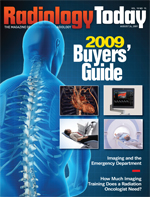 August 24, 2009
August 24, 2009
8 Pitfalls to Productivity
By Jim Knaub
Radiology Today
Vol. 10 No. 15 P. 6
Eduard Michel, MD, PhD, is the chief medical officer and a cofounder of teleradiology provider Virtual Radiologic Corporation (VRC). Besides providing quality interpretation, VRC's success depends on radiologist efficiency. The company has developed its own systems and procedures for improving workflow efficiency. Michel discussed eight pitfalls to workflow efficiency in a digital radiology environment at the AHRA annual meeting earlier this month. Smaller groups and facilities may not have the resources and expertise at their immediate disposal to implement all of Michel's suggestions, but his pitfalls list still represents eight areas of investigation for organizations seeking to improve their workflow.
1. Radiology worklist. An intelligent worklist utilizes software to prioritize studies for reading, allocate cases to radiologists, and balance the workload to the available readers. It also helps avoid case cherry picking by radiologists. Michel said that if doctors are permitted to pick cases from a generalized worklist, many would tend to pick less complicated cases. That can lead to an unread pile of complicated cases at the end of the day or the shift.
2. Vision-dependent workflow navigation. When a radiologist looks away from the image on the screen to navigate through the PACS, RIS, or dictation system, time is lost. It may not seem like much, but those seconds add up. The solution to this problem is what Michel called “eyes-free” navigation. There are a wide range of specialty input devices that permit the radiologist to program mouse and keyboard actions into a multibutton controller, so the doctor can do more work without having to look away from an image.
3. Comparison cases on film or disk. Outside studies slow down radiologists when they must import images from CDs or refer to prior films in a disorganized manner. Michel suggests developing a process for importing films or old PACS and RIS data onto the system before the cases get to the radiologists. He also pointed out that importing images into your PACS raises legal issues surrounding the responsibilities and liabilities for maintaining images “that aren't ours.” He suggested the option of housing such images on a separate server that is purged weekly (or some other frequent interval).
4. Multiple worklists on multiple computers. The lack of integration between computer applications often forces radiologists to jump between workstations to accomplish different tasks. All that switching costs time. The solution, Michel said, is a system with one worklist that launches images, opens RIS studies, and opens the dictation workflow.
5. Inadequate bandwidth/bottlenecks/scaling. This is less of a problem if your radiologists do all their work from the hospital, Michel said, but it becomes a larger issue the more distributed your radiologists are. His solutions are straightforward:
• Don’t skimp on bandwidth.
• Set up your system so data transfers occur before the radiologists open the study.
• Have your worklist software predict which radiologist will read the next study and download the images to his or her workstation.
The increasing number of images in a study requires more time to download. If the rules driving your worklist precache the image for the appropriate radiologist, it can save the doctor significant time. For example, if it takes two minutes per case to download, the radiologist who must wait for the images to download before reading them wastes one hour for every 30 studies.
6. Disparate PACS, RIS, and dictation systems. Many radiologists work in environments where they read for multiple locations using multiple systems and workflows. Such an arrangement can pose numerous problems because many systems do not work well together. Where possible, minimizing the number of systems and aggregating them onto a single reading platform makes the radiologist more efficient.
7. Physicians performing nonphysician work. Michel firmly believes that physicians shouldn’t spend their time performing tasks that don’t require their expertise, particularly tracking down referring physician clinicians to deliver study results. Doctors should spend a minimal amount of time pursuing other doctors’ staff. A solid system for delivering clinical results to the appropriate person should be built into your reporting system.
8. Outdated systems. Improving return on investment can be an impossible challenge if you’re using an outdated system that you can’t update. Replacing such a system is the obvious first option, but if the capital is not available to do that, investigate how you might be able to modify your current applications to improve efficiency.
— Jim Knaub is editor of Radiology Today.

